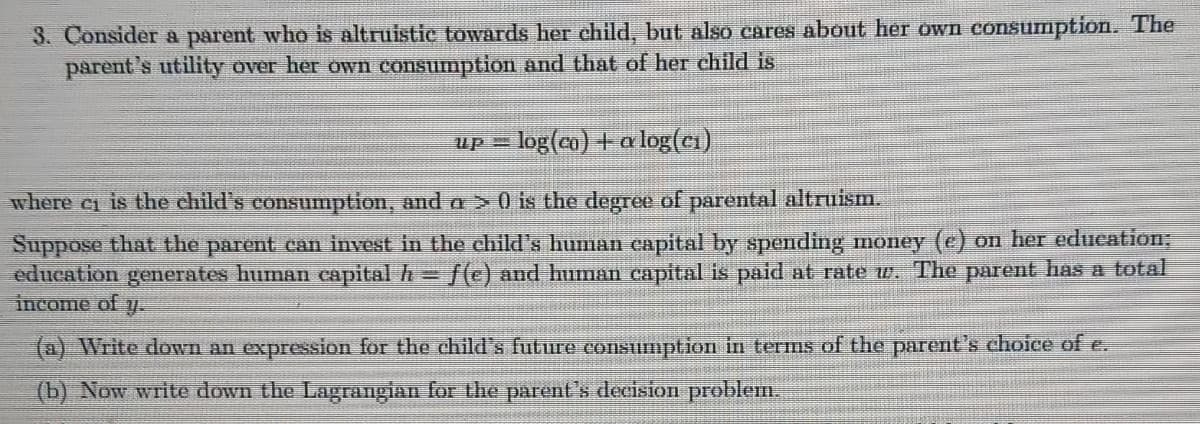3. Consider a parent who is altruistic towards her child, but also cares about her own consumption. The parent's utility over her own consumption and that of her child is up log(co) + a log(c₁) where c₁ is the child's consumption, and a > 0 is the degree of parental altruism. Suppose that the parent can invest in the child's human capital by spending money (e) on her education; education generates human capital h = f(e) and human capital is paid at rate w. The parent has a total income of y. (a) Write down an expression for the child's future consumption in terms of the parent's choice of e. (b) Now write down the Lagrangian for the parent's decision problem.
3. Consider a parent who is altruistic towards her child, but also cares about her own consumption. The parent's utility over her own consumption and that of her child is up log(co) + a log(c₁) where c₁ is the child's consumption, and a > 0 is the degree of parental altruism. Suppose that the parent can invest in the child's human capital by spending money (e) on her education; education generates human capital h = f(e) and human capital is paid at rate w. The parent has a total income of y. (a) Write down an expression for the child's future consumption in terms of the parent's choice of e. (b) Now write down the Lagrangian for the parent's decision problem.
Principles of Microeconomics
7th Edition
ISBN:9781305156050
Author:N. Gregory Mankiw
Publisher:N. Gregory Mankiw
Chapter21: The Theory Of Consumer Choice
Section: Chapter Questions
Problem 11PA
Related questions
Question

Transcribed Image Text:3. Consider a parent who is altruistic towards her child, but also cares about her own consumption. The
parent's utility over her own consumption and that of her child is
up = log(co) +a log(ci)
where c is the child's consumption, and a > 0 is the degree of parental altruism.
Suppose that the parent can invest in the child's human capital by spending money (e) on her education;
education generates human capital h /() and human capital is paid at rate w. The parent has a total
income of
(a) Write down an expression for the child's future consumption in terms of the parent's choice of e.
(b) Now write down the Lagrangian for the parent's decision problem.
Expert Solution
This question has been solved!
Explore an expertly crafted, step-by-step solution for a thorough understanding of key concepts.
This is a popular solution!
Trending now
This is a popular solution!
Step by step
Solved in 3 steps

Knowledge Booster
Learn more about
Need a deep-dive on the concept behind this application? Look no further. Learn more about this topic, economics and related others by exploring similar questions and additional content below.Recommended textbooks for you

Principles of Microeconomics
Economics
ISBN:
9781305156050
Author:
N. Gregory Mankiw
Publisher:
Cengage Learning


Principles of Microeconomics
Economics
ISBN:
9781305156050
Author:
N. Gregory Mankiw
Publisher:
Cengage Learning
